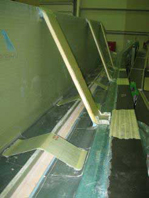Structural Solutions to Save Weight in Future Blades
 Recent work at Risø DTU on wind turbine blades has shown that more failure mechanisms need to be taken into account than just the classical ones such as buckling, material failure, etc. An example of one of the failure modes, which is not part of a certification process, is the non-linear out-of-plane deformation of the load-carrying cap laminate, which introduces interlaminar shear stresses in the load-carrying laminate. This could be the reason for some of the failures in today’s wind turbine blades. This failure mechanism is taken into account in the design of a new, innovative 40m load-carrying box girder presented in this article.
Recent work at Risø DTU on wind turbine blades has shown that more failure mechanisms need to be taken into account than just the classical ones such as buckling, material failure, etc. An example of one of the failure modes, which is not part of a certification process, is the non-linear out-of-plane deformation of the load-carrying cap laminate, which introduces interlaminar shear stresses in the load-carrying laminate. This could be the reason for some of the failures in today’s wind turbine blades. This failure mechanism is taken into account in the design of a new, innovative 40m load-carrying box girder presented in this article.
By Find M. Jensen, Risø National Laboratory for Sustainable Energy, Denmark
 Recent work at Risø DTU on wind turbine blades has shown that more failure mechanisms need to be taken into account than just the classical ones such as buckling, material failure, etc. An example of one of the failure modes, which is not part of a certification process, is the non-linear out-of-plane deformation of the load-carrying cap laminate, which introduces interlaminar shear stresses in the load-carrying laminate. This could be the reason for some of the failures in today’s wind turbine blades. This failure mechanism is taken into account in the design of a new, innovative 40m load-carrying box girder presented in this article.
Recent work at Risø DTU on wind turbine blades has shown that more failure mechanisms need to be taken into account than just the classical ones such as buckling, material failure, etc. An example of one of the failure modes, which is not part of a certification process, is the non-linear out-of-plane deformation of the load-carrying cap laminate, which introduces interlaminar shear stresses in the load-carrying laminate. This could be the reason for some of the failures in today’s wind turbine blades. This failure mechanism is taken into account in the design of a new, innovative 40m load-carrying box girder presented in this article.By Find M. Jensen, Risø National Laboratory for Sustainable Energy, Denmark










